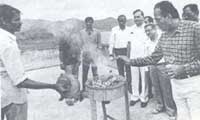From deluge to drought
 BOMBAY's residents are always ready for a deluge -- it is drought that they fear. And, the grim sceptre of waterless days has risen this year. Water levels in lakes Vaitarana, Tansa, Tulsi and Vihar have dipped to within two metres above drawable level. With the monsoon playing truant, city officials have considered almost every option, from the prosaic -- launching Operation Evacuation and shutting down industrial and commercial activity -- to the flamboyant -- cloud-seeding at Vaitarna lake. Cloud seeding is a technique used to generate rainfall artificially by using an aircraft to bombard a cloud with silver iodide or salt crystals.
BOMBAY's residents are always ready for a deluge -- it is drought that they fear. And, the grim sceptre of waterless days has risen this year. Water levels in lakes Vaitarana, Tansa, Tulsi and Vihar have dipped to within two metres above drawable level. With the monsoon playing truant, city officials have considered almost every option, from the prosaic -- launching Operation Evacuation and shutting down industrial and commercial activity -- to the flamboyant -- cloud-seeding at Vaitarna lake. Cloud seeding is a technique used to generate rainfall artificially by using an aircraft to bombard a cloud with silver iodide or salt crystals.
As the cash-strapped city administrators could not afford aircraft they opted instead for a cheaper option: seeding from ground-level by blowing silver iodide into scorching coal so that the vapour would rise slowly into the clouds and, hopefully, bring on rain. However, even before the particles hit the clouds, a raging controversy broke out with some meteorologists dismissing the exercise as "unscientific". They contended that ground-seeding necessitated clouds at low level and these would result in rain anyway.
Related Content
- The United Nations World Water Development Report 2020: Water and Climate Change
- Uncharted waters: the new economics of water scarcity and variability
- India State of the Environment Report : The Monthly Overview, September 2013
- Mumbai, Miami on list for big weather disasters
- Drought, flood, snow and cold hit global commodities
- Floods blacked out but real
